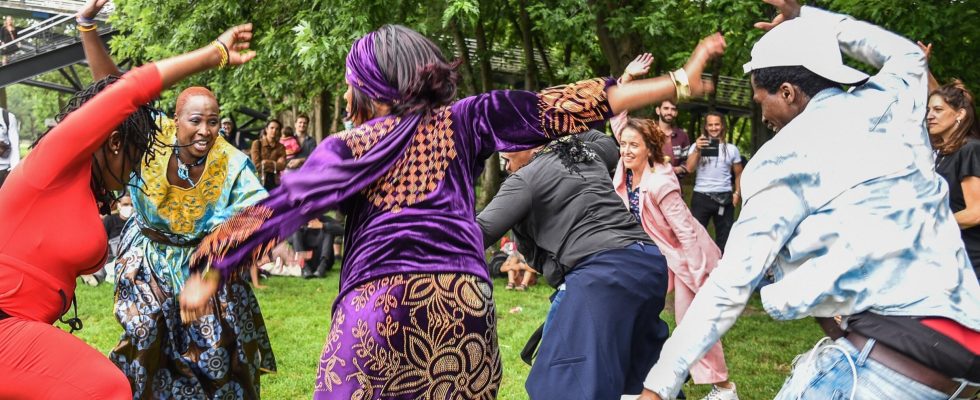Former backing vocalist for Mory Kanté and other greats of the African scene, Aïssata Kouyaté became a dancer and dance teacher. With her very young company, Kobe Na Awati, this strong woman wants to defend the traditions of her native country, Guinea, and perpetuate its vibrant rhythms.
5 mins
Dyed hair shaved very short, large colorful earrings to match her bracelets, and a wide smile. Aïssata Kouyaté exudes a quiet strength. However, you have to hear her cracked voice and let this rather reserved fifty-year-old speak at length to realize that her path has not always been simple.
Born into a family of griots in Kissidougou, in central Guinea, Aïssata grew up with her mother and her paternal grandfather. When the latter died, she was sent to Conakry to live with a singer aunt. Of school age, the 10-year-old child is instead placed in a family of notables as a maid. She cries often and manages to run away. Finally caught by her aunt, she “ find yourself doing housework for the whole family » and lives his “ worst ordeal “.
While she and this aunt are preparing for a show by the Ensemble instrumental de Guinée, a conservatory training in traditional instruments (ngoni, kora, balafon, etc.), Aïssata sings with them. The young girl clings to music and joins the African Ballets for two years, even if she has to face the jealousy of her bad fairy and be beaten for it. She also escapes forced marriage, discouraging her suitors.
International tours with Mory Kanté
Her good fairy will be called Mory Kanté. The singer and musician was already a star when she met him; he triumphed all over the world with the tube “Yeké yeké”. The teenager was spotted during a concert given at the Palais du peuple in Conakry. We also hear her on the radio where she sometimes provides backing vocals. She is auditioned. She was barely 17 years old when she flew with a visa to France, to be a chorister, and still remembers September 5, 1990 when she arrived at Roissy-Charles-de-Gaulle airport. Extremely shy, she doesn’t speak French and will learn this language on the job.
Through contact with Mory Kanté, Aïssata “grows up” and learns the trade. “ He and I were just jokes. As his wife was a Kouyaté, I was her “sister-in-law”. I could tell him everything. Whenever he wasn’t feeling well, he would come and tease me for a laugh. But I didn’t let myself do it “, she remembers. Aïssata travels constantly. His school of life is on international tours, within a team where Africans and Westerners mix without making any differences. The young woman is content with little, saves her money, and above all is keen to “fit in”.
Traditional African dance, a space of freedom
In parallel with a career as a singer where she also accompanies the Senegalese Toure Kunda or takes part in the Andouma trio, which mixes jazz and Mandingo music, Aïssata rediscovers traditional dance. Little by little, dance becomes his breathing between two planes. She collaborated with the djembe player Mamady Keita or with African dance ballets like Nimba in England, and began teaching. Above all, she joined the company of the Ivorian dancer and choreographer Georges Momboye, to whom she remained married for seven years.
Working with her husband, the griotte became a figure in African dance in Paris. It is now installed in an MJC (House of Youth and Culture) in eastern Paris. It is to defend her traditions that she created her association, Aïba, and in 2021 her own company, Kobe Na Awati – whose name means “ Everything in its time » in Malinké. She sings and dances to rhythms which, like Doundounba, Kuku, or Makuru, are linked to moments of daily life.
Like other African dances, Guinean dance is an explosive art, to say the least. Accompanied by percussionists who play very loudly, the dancers put their steps in unison with the drums and roll their lower backs and shoulders to better extend themselves. The movements are quick and well anchored in the ground. This gives rise to powerful solos and unisons during which the energy shared between the musicians and the dancers brings everyone out of themselves and can lead to a trance.
“ An artist has no fixed place »
With her two grown children, Jérémy, 29, and Fatime, 20, her relatives, and students who religiously follow her classes, Aïssata now has her ties to Paris. If she teaches dance all over Europe and as far as Japan, she returns as soon as she can to Guinea to “ recharge your batteries “. So, has she become more French than Guinean? “ This is a question I often ask myselfshe assures. An artist always remains like a tourist. We don’t have a fixed location, we travel a lot. As I came to France at 17, I am a French citizen, I am well received and I have my place here. But I remain a stranger. And when I go to Guinea, people no longer see me as Guinean, they also welcome me as a foreigner. We know that I’m only coming for a while. »
Each time she returns, Aïssata introduces her students to the country of her origins during intensive dance courses. . His last show,Taa Maa, story of a woman and traditional Guinean music
https://www.youtube.com/watch?v=fwBmk9PsS5w
